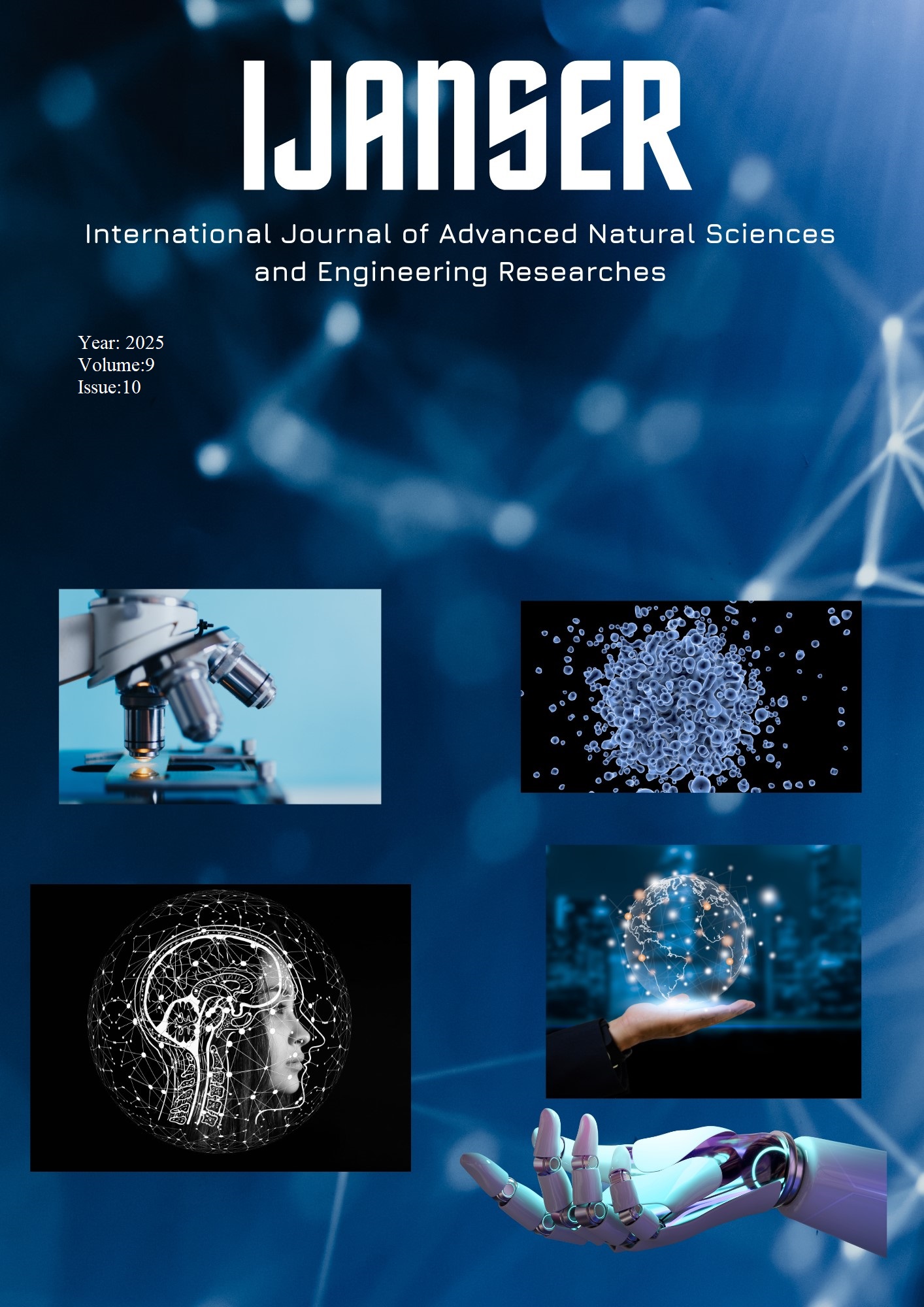Statistical and experimental analysis of machining parameters and tool radius in turning of low carbon steels
Keywords:
ANOVA, 1015, Cutting Force, Surface Roughness, MachinabilityAbstract
In this study, the effects of basic machining parameters and insert radius on machinability
during turning of low-carbon steels were investigated using experimental and statistical methods. The
experiments were conducted on AISI 1015 case-hardened steel, and speed, depth, feed, and insert radius
were considered as input parameters. Output parameters were determined as roughness and cutting force.
The full factorial method was used for the experimental design, and the obtained data were evaluated
using ANOVA. The results show that feed and insert radius are particularly decisive on roughness. At
low feed and high cutting speed, a 0.8 mm insert radius provides optimum surface quality. Cutting force
increases in direct proportion to depth of cut and feed, while decreasing with increasing speed. It was also
observed that tools with a 0.4 mm insert radius exhibit lower force values. According to the ANOVA
results, feed was the parameter that most affected surface roughness at a 0.4 mm tip radius, while depth
was the most critical parameter determining force at a 0.8 mm tip radius. Consequently, this study
provides guidance in selecting optimal cutting parameters to achieve high efficiency and desired
tolerances in manufacturing processes.
Downloads
References
I. Vakulenko, S.O. Plitchenko, A.F. Yılmaz, Influence Degree and Scheme of Hot Reduction on Properties of the Carbon Steel, Manufacturing Technologies and Applications, 6 150-156.
C. Moganapriya, R. Rajasekar, P. Sathish Kumar, T. Mohanraj, V. Gobinath, J. Saravanakumar, Achieving machining effectiveness for AISI 1015 structural steel through coated inserts and grey-fuzzy coupled Taguchi optimization approach, Structural and Multidisciplinary Optimization, 63 (2021) 1169-1186.
B.S. Kul, Effect of Cutting Parameters in Turning of AISI 1015 Steel: Comparison of Dry and MQL Conditions, European Journal of Technique (EJT), 14 154-159.
M. Günay, M.Ö. Kayki, A.F. Yilmaz, Comprehensive analysis of FEM assisted cermet insert design and tool performance for turning bearing rings, Sādhanā, 50 (2025) 180.
R. Binali, S. Yaldız, S. Neşeli, Finite element analysis and statistical investigation of S960ql structure steel machinability with milling method, Journal of the Brazilian Society of Mechanical Sciences and Engineering, 46 (2024) 260.
R. Binali, A.D. Patange, M. Kuntoğlu, T. Mikolajczyk, E. Salur, Energy saving by parametric optimization and advanced lubri-cooling techniques in the machining of composites and superalloys: A systematic review, Energies, 15 (2022) 8313.
A.S. Yamaner, B.S. Kul, Evaluation of tool radius and machining parameters on cutting forces and surface roughness for AA 6082 aluminum alloy, European Mechanical Science, 9 (2025) 125-138.
A.F. Yilmaz, M. Konal, Topology Optimization-Driven Design of Container Ship Hatch Cover for Lightweight Performance and Cost Efficiency, Journal of Offshore Mechanics and Arctic Engineering, 147 (2025) 041701.
M. Günay, M.E. Korkmaz, N. Yaşar, Performance analysis of coated carbide tool in turning of Nimonic 80A superalloy under different cutting environments, Journal of Manufacturing Processes, 56 (2020) 678-687.
M.A. Makhesana, K. Patel, N. Ghetiya, R. Binali, M. Kuntoğlu, Evaluation of drilling and hole quality characteristics in green machining aluminium alloys: A new approach towards green machining, Journal of Manufacturing Processes, 129 (2024) 176-186.
A. Yılmaz, M. Günay, Modeling of Surface Roughness and Cutting Temperature in Turning Er6 Steel, in: Ü. Baxşiyeva (Ed.) Arceng IV. International Ankara Scientific Studies Conference, Ankara, Türkiye, 2025, pp. 131-138.
M. Kuntoğlu, A. Aslan, D.Y. Pimenov, Ü.A. Usca, E. Salur, M.K. Gupta, T. Mikolajczyk, K. Giasin, W. Kapłonek, S. Sharma, A review of indirect tool condition monitoring systems and decision-making methods in turning: Critical analysis and trends, Sensors, 21 (2020) 108.
R. Binali, M. Kuntoğlu, an in-depth analysis on the surface roughness variations during turning of GGG50 ductile cast iron, Doğu Fen Bilimleri Dergisi, 5 (2022) 41-49.
B.S. Kul, A.S. Yamaner, A Comparative Evaluation of Dry-MQL Turning Applications for AISI 5115 Steel, Manufacturing Technologies and Applications, 6 23-32.
H. Demirpolat, Evaluation of the turning parameters of AISI 5115 steel in dry and MQL cutting environments with the use of a coated carbide cutting insert: An experimental study, Journal of Materials and Mechatronics: A, 5 (2024) 168-182.
M. Kuntoğlu, H. Demirpolat, R. Binali, M.E. Korkmaz, M. Makhesana, K. Kaya, Sustainable Lubrication Strategies in Eco-friendly Machining of AISI 4140 Steel: Performance and Environmental Impact Analysis Using Machine Learning, Journal of Materials Engineering and Performance, (2025) 1-17.
N. Kavak, AISI 1040 çeliğinin kuru tornalanmasında yüzey pürüzlülüğünün incelenmesi, Karaelmas Fen ve Mühendislik Dergisi, 2 (2012) 24-29.
R. Binali, S. Yaldız, S. Neşeli, S960QL yapı çeliğinin işlenebilirliğinin sonlu elemanlar yöntemi ile incelenmesi, Avrupa Bilim ve Teknoloji Dergisi, (2021) 85-91.
M. Ali, T.A.H. Ratlamwala, G. Hussain, T. Shehbaz, R. Muhammad, M. Aamir, K. Giasin, D.Y. Pimenov, Machining of Carbon Steel under Aqueous Environment: Investigations into Some Performance Measures, Coatings, 12 (2022) 1203.
M. Shnfir, O.A. Olufayo, W. Jomaa, V. Songmene, Machinability study of hardened 1045 steel when milling with ceramic cutting inserts, Materials, 12 (2019) 3974.
K.h. Salman, A.H. Elsheikh, M. Ashham, M.K.A. Ali, M. Rashad, Z. Haiou, Effect of cutting parameters on surface residual stresses in dry turning of AISI 1035 alloy, Journal of the Brazilian Society of Mechanical Sciences and Engineering, 41 (2019) 1-12.
S. Kumar, I. Saravanan, L. Patnaik, Optimization of surface roughness and material removal rate in milling of AISI 1005 carbon steel using Taguchi approach, Materials today: proceedings, 22 (2020) 654-658.
S. Paul, N. Dhar, A. Chattopadhyay, Beneficial effects of cryogenic cooling over dry and wet machining on tool wear and surface finish in turning AISI 1060 steel, Journal of Materials Processing Technology, 116 (2001) 44-48.
R. Binali, H. Demirpolat, M. Kuntoğlu, K. Kaya, Exploring the Tribological Performance of Mist Lubrication Technique on Machinability Characteristics During Turning S235JR Steel, Manufacturing Technologies and Applications, 5 (2024) 276-283.
A.B.A.M.A. Abdullah, A.R. Mohammed, Optimization of Drilling Parameter on Surface Roughness using Taguchi Method.





